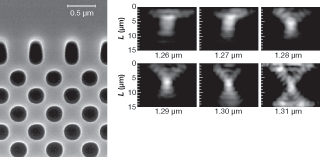|
Negative refraction and focusing of millimeter waves by
dielectric-rod-type or air-hole-type 2-D photonic crystals (PCs) has
been demonstrated; however, focusing light waves is more difficult
due to observed weak optical confinement and unwanted
reflection/diffraction of light waves in a PC structure. Recognizing
that a high-index-contrast PC slab using a silicon-on-insulator
(SOI) substrate can enhance optical confinement (despite increasing
diffraction and reflection losses), researchers at Yokohama National
University (Yokohama, Japan) used finite-difference time-domain
(FDTD) simulations to model an optimum interface that reduces these
losses and successfully fabricated the structure to demonstrate
focusing of 1.26 to 1.42 µm light by negative refraction.1
The SOI substrate consisted of 0.26-µm-thick silicon (Si) and
1.0-µm-thick silicon dioxide (SiO2) layers. Device patterns were
formed using electron-beam lithography and plasma etching, and the
air-bridge PC structure was formed using hydrofluoric wet etching.
The PC structure consists of air holes in a square lattice rotated
by 45°, with a linear array of deformed air holes just at the SOI
boundary that reduces optical reflection and diffraction (see
figure). The deformed air holes have a round front shape and a
triangular back shape. The FDTD simulations dictated that, for
negative refraction to occur in the superlens, the air-hole diameter
normalized by the PC lattice constant should equal 0.689 and the
effective refractive index of the PC slab should be 2.963 (the
lattice constant is 0.45 µm).

Click here to enlarge
image
A
photonic-crystal superlens on an SOI substrate has deformed
air holes (left) that reduce optical reflection and
diffraction, which normally makes focusing of light impossible
for such a high-index-contrast interface. Laser light with
wavelengths between 1.26 and 1.31 µm is focused by
negative-refraction effects as demonstrated by observing the
near-field pattern within the superlens (above).
|
To demonstrate focusing by the fabricated superlens, a
silicon-wire waveguide with 0.5 µm width was used as the source of
the Gaussian input to the superlens. The fabrication of the wire
waveguide included mode expanders to ensure smooth light
transmission. The waveguide was connected to a 77-µm-long Si slab
and the full-width at half-maximum of the Gaussian beam (after
exiting the wire and traveling through the Si slab) was around 13 µm
at the input end of the superlens to satisfy another FDTD
requirement that the divergence of the angle of incident light to
the superlens be within 12° for negative refraction to occur.
To study the focusing effect over a range of wavelengths, a
tunable laser source was used to deliver light to the wire waveguide
and through the Si slab to the superlens. For wavelengths between
1.26 and 1.31 µm, focusing was clearly observed within the superlens
through direct observation of radiated light in the near-field
pattern within the superlens. For longer wavelengths beyond 1.31 µm,
smaller angular components are not as easily observed and require
more-complex methods; however, focusing was observed over a
wavelength range from 1.26 to 1.42 µm. Comparison between FDTD
simulations and experimental results was favorable.
The superlens fabricated by the researchers can produce a minimum
focused-spot width of 1.8 µm. “The superlens is unique because it
forms a real image by its flat surface and its lensing
characteristics are independent of light input position,” says
researcher Toshihiko Baba. “It has the potential of changing the
design rules for optical couplers and imaging systems. We are now
planning to demonstrate the position-independent focusing
characteristics and some unique components based on this lens, such
as optical cavities and waveguides.”
Gail Overton
1. T. Matsumoto et al., Optics
Lett. 31(18) 2786 (Sept. 15, 2006). Laser Focus
World October, 2006
Author(s) : Gail Overton
| 


